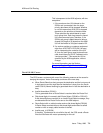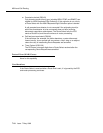
ASAI and Call Routing
7-6 Issue 7 May 1998
Route Select
This capability allows the adjunct to provide the ECS with the destination address
to which the call should be routed. In addition, the adjunct can request the ECS to
route the call as a direct-agent call and/or a priority call. The first Route Select
received cancels all other outstanding requests.
Starting with G3V3, the following features provide additional functionality:
■ ASAI-Provided Digits allows an adjunct to include digits in a Route Select
capability. These digits are treated as dial-ahead digits for the call, which
are stored in a dial-ahead digit buffer. They can be collected one at a time
or in groups using the collect digits vector command(s).
■ ASAI-Requested Digit Collection gives an adjunct the ability to request
that a DTMF tone detector (TN744) be connected to detect user-entered
digits. The request is made via an option of the Route Select message. The
digits collected as a result of this feature are passed to ASAI monitoring
and/or controlling adjuncts for action. The ECS handles these digits like
dial-ahead digits.
These digits are collected while the call is not in vector processing. They
are sent to an ASAI adjunct, and/or they may be used by Call Prompting
features.
Starting with R5, if a touch tone receiver (TTR) is connected to a call as a
result of an ASAI-Requested Digit Collection parameter in a Route Select
message, and the call encounters a “collect ced digits” or “collect cdpd
digits” step in vector processing, then the TTR will be disconnected from
the call. In addition, any ASAI-Request digits stored in the dial-ahead buffer
when the “collect ced digits” or “collect cdpd digits” step is encountered, are
deleted and no Entered Digits Event Report is sent.
■ User to User Information (UUI) allows distributed CallVisor ASAI and
ACD users to associate caller information with a call. This information may
be a customer number, credit card number, alphanumeric digits, or a binary
string. It is propagated with the call whether the call is transferred or routed
to a destination on the local ECS or to a destination on a remote ECS. Up
to 32 bytes are allowed.
An ASAI adjunct can include the UUI for a call in a Route Select. If the call
is routed to a remote ECS over PRI trunks, the ECS sends the UUI in the
ISDN SETUP message used to establish the call. The local and remote
switches include the UUI in the Call Offered to Domain and Alerting Event
Reports and in any Route Requests sent by the ECS for the call.
Information Flow
The adjunct sends the destination address to the ECS.
The ECS accepts and reroutes the call if vector processing is executing either a
wait time or announcement steps. If the destination address is invalid, the ECS


















